1. мДЬ л°†
1.1 мЧ∞кµђ л∞∞к≤љ
мЧ∞кЄ∞к∞РмІАкЄ∞лКФ нЩФмЮђміИкЄ∞мЧР к≤љл≥іл•Љ л∞ЬнХШлКФ мЮ•м†РмЭД к∞АмІАк≥† мЮИмІАлІМ нШДмЮђкєМмІАлПД мШ§мЮСлПЩ л∞П лѓЄмЮСлПЩмЧР кіАнХЬ лђЄм†Ьл•Љ мХЉкЄ∞нХШк≥† мЮИлЛ§(
Hwang, 2023). мЧ∞кЄ∞к∞РмІАкЄ∞мЧР кіАнХЬ лђЄм†Ьл•Љ нХік≤∞нХШкЄ∞ мЬДнХімД† мЧ∞кЄ∞к∞РмІАкЄ∞мЭШ мЭСлЛµнКємД±мЧР кіАнХЬ мЭінХік∞А нХДмЪФнХШлЛ§.
мЧ∞кЄ∞к∞РмІАкЄ∞мЭШ мЭСлЛµнКємД±мЧР кіАнХЬ мЧ∞кµђл•Љ мВінОіл≥Є к≤∞к≥Љ кµ≠лВімЩЄмЧРмДЬ мЭСлЛµнКємД±мЧР кіАнХЬ мЧ∞кµђл•Љ нЖµнХі к∞РмІАкЄ∞мЭШ мЛ†лҐ∞мД±мЭД лЖТмݳ놧лКФ лŪ놕мЭА мІАмЖНм†БмЬЉл°Ь мЭіл£®мЦімІАк≥† мЮИлЛ§. кµ≠мЩЄмЭШ к≤љмЪ∞,
Heskestad (1975)лКФ мЧ∞кЄ∞к∞РмІАкЄ∞мЭШ мЮЕкµђм†АнХ≠мЭД мЭімЪ©нХі мЭСлЛµнКємД±мЧР лМАнХЬ мЛЭмЭД м†ЬмЛЬнХШмШАк≥† мЛЬк∞ДмГБмИШмЭШ к∞ЬлЕРмЭД лПДмЮЕнХШмЧђ мЧ∞кЄ∞к∞РмІАкЄ∞мЭШ мЩЄлґАмЩА лВілґАмЭШ кіСнХЩл∞АлПД м∞®мЭіл•Љ лПДмґЬнХШлКФ мЛЭмЭД м†ХмЭШнХШмШАлЛ§.
Bjorkman et al. (1992)мЭА HeskestadмЭШ мЭСлЛµнКємД±мЧР кіАнХЬ мЛЭмЧРмДЬ м†ХмЭШлРШлКФ мЛЬк∞ДмГБмИШмЭШ мШБнЦ•мЭЄмЮРмЭЄ нКємД±кЄЄмЭіл•Љ лЛ§мЦСнХЬ к∞РмІАкЄ∞мЧР лМАнХШмЧђ лПДмґЬнХШмШАлЛ§.
Cleary et al. (1999)мЭА к∞РмІАкЄ∞мЭШ лђЉл¶ђм†Б л∞ШмЭСмЭД к≤∞м†ХнХШкЄ∞ мЬДнХЬ Test-bed FE/DE (Fire-emulator/Detector-Evaluator)л•Љ м†Ьк≥µнХШмШАмЬЉл©∞, лєДнЩФмЮђл≥і мЛЬ л∞ЬмГЭнХШлКФ к∞РмІАкЄ∞ мДЉмДЬмЭШ л∞ШмЭСмЧР лМАнХімДЬ лґДмДЭнХШмШАлЛ§.
кµ≠лВімЭШ к≤љмЪ∞
Roh (2012)лКФ кіСм†ДмЛЭ мЧ∞кЄ∞к∞РмІАкЄ∞мЭШ мЧ∞кЄ∞ мЭСлЛµнКємД±мЭД мЛ§нЧШнХШмЧђ мД±лК•мЬДм£ЉмД§к≥Д мЛЬ м†БмЪ©нХШлКФ нЩФмЮђ к∞РмІАмЛЬк∞Д мВ∞м†Хл∞©л≤ХмЭД м†ЬмХИнХШмШАмЬЉл©∞, кЄ∞л•ШмЖНлПДмЩА кіА놮нХШмЧђ мЧ∞кЄ∞к∞РмІАкЄ∞ мЭСлЛµнКємД±мЧР кіАнХШмЧђ мЧ∞кµђл•Љ мИШнЦЙнХШмШАлЛ§. лШРнХЬ
Kim and Hwang (2013)мЭА Heskestad л∞П ClearyмЭШ мЧ∞кµђл•Љ кЄ∞л∞ШмЬЉл°Ь FDE (Fire Detector Evaluator) мЮ•мєШл•Љ м†ЬмЮСнХШмЧђ FDSмЧРмДЬ Default к∞ТмЬЉл°Ь м†БмЪ©лРШлКФ мЧ∞кЄ∞к∞РмІАкЄ∞мЭШ мЭСлЛµнКємД± к∞Тк≥Љ кµ≠лВі лМАнСЬм†БмЭЄ мЧ∞кЄ∞к∞РмІАкЄ∞мЭШ мЭСлЛµнКємД± к∞ТмЭШ м†ХлЯЙм†БмЭЄ лєДкµРл•Љ мИШнЦЙнХШмШАлЛ§. лєДкµРл•Љ нЖµнХі мЄ°м†ХлРЬ мЮ•мєШлђЉмД±мЭА FDSмЧР м†БмЪ©лРЬ кЄ∞л≥Єк∞Тк≥Љ лІ§мЪ∞ нБ∞ м∞®мЭіл•Љ л≥імЭік≥† мЮИмЬЉл©∞ к∞РмІАмЛЬк∞ДмЧРлПД нБ∞ м∞®мЭіл•Љ лВШнГАлВі мґФк∞Ам†БмЭЄ мЧ∞кµђл•Љ нЖµнХі лН∞мЭінД∞л≤†мЭімК§ кµђмґХмЭі нХДмЪФнХШлЛ§к≥† м†ЬмЦЄнХШмШАлЛ§.
мД†нЦЙмЧ∞кµђл•Љ к≤АнЖ†нХЬ к≤∞к≥Љ HeskestadмЭШ мЧ∞кµђл•Љ кЄ∞л∞ШмЬЉл°Ь кµ≠лВівЛЕмЩЄмЧРмДЬ мЧ∞кЄ∞к∞РмІАкЄ∞мЭШ мЭСлЛµнКємД±мЧР кіАнХЬ мЧ∞кµђк∞А мІАмЖНм†БмЬЉл°Ь мИШнЦЙлРШмЧИлЛ§. кЈЄлЯђлВШ м°∞мВђлРЬ кµ≠лВівЛЕмЩЄ мД†нЦЙмЧ∞кµђ л™®лСР FE/DEмЩА к∞ЩмЭА мЖМкЈЬл™® мЛ§нЧШмЮ•мєШ лВімЧРмДЬ мЧ∞кЄ∞к∞РмІАкЄ∞мЭШ мЭСлЛµнКємД±мЭД нЩХмЭЄнХШмШАлЛ§. кЈЄл†ЗкЄ∞мЧР мІДнЦЙлРЬ мЧ∞кµђмЧРмДЬ Heskestadк∞А м†ЬмЛЬнХЬ мЧ∞кЄ∞к∞РмІАкЄ∞ мЭСлЛµнКємД± мЛЭмЭШ мШБнЦ•мЭЄмЮРмЭЄ мЛЬк∞ДмГБмИШмЩА нКємД±кЄЄмЭімЧР лМАнХЬ мЛ§кЈЬл™®нЩФмЮђмЛ§нЧШмЭА лґАм°±нХЬ мЛ§м†ХмЭілЛ§.
Table 1мЧР мД†нЦЙмЧ∞кµђмЧРмДЬ Heskestad мЭіл°† м†БмЪ© мЧђлґА л∞П мЛ§мЛЬнХЬ нЩФмЮђ мЛ§нЧШмЭШ кЈЬк≤©мЧР лМАнХШмЧђ лВШнГАлВімЧИлЛ§.
Table 1
Previous Literature of Heskestad and Test Method for Scale
мЧ∞кЄ∞к∞РмІАкЄ∞лКФ к∞Б к∞АмЧ∞лђЉмЭШ мҐЕл•ШмЧР лФ∞лЭЉ мЭСлЛµмД±мЭШ м∞®мЭілКФ мЮИмІАлІМ нЩФмЮђлЭЉлКФ мВђмЛ§мЭД л∞ЭнЮИлКФ лН∞ кЈЄ л™©м†БмЭД лСРлѓАл°Ь мЭСлЛµмЭШ мЬ†мВђмД±мЭі нХДмЧ∞м†БмЬЉл°Ь м°імЮђнХЬлЛ§. мЭіл•Љ мИШмєШнЩФнХЬлЛ§л©і мЭСлЛµмЧР лМАнХЬ мЭінХік∞А кЈєлМАнЩФлР† к≤ГмЭілЛ§. лФ∞лЭЉмДЬ мЧ∞кЄ∞к∞РмІАкЄ∞мЭШ мЮЕкµђм†АнХ≠, мІАмЧ∞мЛЬк∞Д лУ± мЭСлЛµнКємД±мЭД мЬ†мґФнХШлКФлН∞ мВђмЪ©лРШк≥† мЮИлКФ Heskestad мЭіл°†мЭД мЛ§кЈЬл™®нЩФмЮђмЛ§нЧШмЧР м†БмЪ©нХШк≥† лПДмґЬлРЬ мШБнЦ•мЭЄмЮРмЭШ мЭіл°†к∞Тк≥Љ к≤∞к≥Љк∞ТмЭД лєДкµРвЛЕлґДмДЭнХШмЧђ кµ≠лВі мЧ∞кЄ∞к∞РмІАкЄ∞ мЭСлЛµнКємД± мИШмєШнЩФл•Љ мЬДнХЬ кЄ∞міИмЧ∞кµђл°ЬмН® л≥Є мЧ∞кµђл•Љ мИШнЦЙнХШк≥†мЮР нХЬлЛ§.
1.2 мЧ∞кµђмЭШ л≤ФмЬД л∞П л∞©л≤Х
кµ≠лВі мЧ∞кЄ∞к∞РмІАкЄ∞мЭШ мЭСлЛµнКємД±мЭД нЩХмЭЄнХШкЄ∞ мЬДнХШмЧђ кµ≠лВівЛЕмЩЄ лђЄнЧМмЭД нЩХмЭЄнХШмШАк≥†, мЧ∞кЄ∞к∞РмІАкЄ∞мЭШ мЭСлЛµнКємД±мЭД лВШнГАлВікЄ∞ мЬДнХі Heskestad мЭіл°†мЭД лґДмДЭнХШмШАлЛ§. Heskestad мЛЭмЭШ мШБнЦ•мЭЄмЮРмЭЄ мЛЬк∞ДмГБмИШ(Time constant)мЭШ мЭіл°†к∞Т лПДмґЬ нЫД мЛ§кЈЬл™®нЩФмЮђмЛ§нЧШмЧР м†БмЪ©нХШмЧђ лПДмґЬлРШлКФ мЧ∞кЄ∞к∞РмІАкЄ∞мЭШ нКємД±кЄЄмЭіл°Ь мЭСлЛµнКємД±мЭД мИШмєШнЩФнХШмШАлЛ§. лШРнХЬ мЛЬк∞ДмГБмИШмЭШ нХімДЭмЧР лФ∞л•Є 3к∞АмІА кіАм†РмЭД мД§л¶љнХЬ лТ§, к∞Бк∞БмЭШ нКємД±кЄЄмЭіл•Љ лПДмґЬнХШмШАлЛ§. кіАм†РмЧР мЭШнХі лПДмґЬлРЬ нКємД±кЄЄмЭімЩА мЭіл°†к∞Тк≥ЉмЭШ лєДкµРвЛЕлґДмДЭмЭД нЖµнХі м†БнХ©нХЬ кіАм†РмЭД нЩХмЭЄнХШмШАлЛ§. мЭілЯђнХЬ мЧ∞кµђ л∞©л≤ХмЭД Flow-Chartл°Ь
Fig. 1мЧР лВШнГАлВімЧИлЛ§.
Fig. 1

2. мЭіл°†м†Б к≥†м∞∞
2.1 мЧ∞кЄ∞к∞РмІАкЄ∞ мЭСлЛµнКємД±
мЧ∞кЄ∞к∞РмІАкЄ∞мЭШ мЭСлЛµнКємД±мЭА лЛ§мЦСнХЬ мЭіл°†мЧР мЭШнХі мЭіл£®мЦімІДлЛ§. кЈЄ м§С мЛЬк∞ДмІАмЧ∞л≤ХмЬЉл°Ь лґДл•ШлРШлКФ HeskestadмЭШ мЭіл°†мЭА мЭСлЛµнКємД±мЧР кіАнХШмЧђ мЮЕкµђм†АнХ≠мЧР кіАнХЬ мЛЭмЬЉл°Ь лВШнГАлВЄлЛ§(
SFPE, 2019).
HeskestadмЭШ мЭіл°†мЧР лФ∞л•іл©і мЧ∞кЄ∞к∞РмІАкЄ∞ мД§мєШмЬДмєШмЭШ кіСнХЩл∞АлПДк∞А мЛЬк∞ДмЧР лФ∞лЭЉ м¶Эк∞АнХШлКФ нЩШк≤љмЭЉ лХМ к∞РмІАкЄ∞ лВілґА кіСнХЩл∞АлПДлКФ мЩЄлґА кіСнХЩл∞АлПДл≥ілЛ§ нХ≠мГБ мЮСк≤М лРЬлЛ§. мЭілКФ к∞РмІАкЄ∞мЭШ мЮЕкµђм†АнХ≠мЭі лВілґАл°Ь мЧ∞кЄ∞к∞А мЬ†мЮЕлРШлКФ к≤ГмЭД л∞©нХінХШкЄ∞ лХМлђЄмЭілЛ§. лШРнХЬ кіСнХЩл∞АлПДк∞А мЭЉм†ХнХЬ мЧ∞кЄ∞ мЬ†лПЩ лВімЧР к∞РмІАкЄ∞л•Љ лЖУмХДлСРмЧИмЭД к≤љмЪ∞мЧРлКФ к∞РмІАкЄ∞ лВілґА кіСнХЩл∞АлПДк∞А мЩЄлґАмЭШ кіСнХЩл∞АлПДмЧР кЈЉм†СнХШкЄ∞кєМмІА мЛЬк∞ДмІАмЧ∞мЭі л∞ЬмГЭнХЬлЛ§. мЬДмЭШ мЮЕкµђм†АнХ≠мЧР кіАнХЬ мЭіл°†мЭД мЛЭмЬЉл°Ь лВШнГАлВіл©і лЛ§мЭМк≥Љ к∞ЩлЛ§(
SFPE, 2019).
мЭілХМ ѕДлКФ к∞РмІАкЄ∞мЭШ мЛЬк∞ДмГБмИШл•Љ лВШнГАлВілКФ лЛ®мЬДмЭілЛ§. мЛЬк∞ДмГБмИШлКФ(Time Constant) к≥µнХЩмЧРмДЬ мВђмЪ©лРШлКФ м§СмЪФнХЬ к∞ЬлЕРмЬЉл°Ь мЩЄлґА л≥АнЩФмЧР лМАнХЬ лђЉм≤імЭШ лПЩм†БмЭЄ мЭСлЛµ нКємД±мЭД лВШнГАлВЄлЛ§. м¶Й, к≥µнХЩм†БмЬЉл°Ь м£Љл≥АмЧР лПЩм†БмЭЄ л≥АнЩФк∞А л∞ЬмГЭнХШмШАмЭД лХМ кЈЄ л≥АнЩФмЧР мЭШнХЬ к≥ЉлПДм†Б мГБнГЬк∞А мВђлЭЉмІАк≥† мГИл°ЬмЪі нПЙнШХ мГБнГЬмЧР лПДлЛђнХШлКФ лН∞ нХДмЪФнХЬ мЛЬк∞ДмЭШ кЄЄмЭіл•Љ мЭШлѓЄнХЬлЛ§(
Han, 2013).
Eq. (1)мЭД м†БлґДнХЬ лТ§ міИкЄ∞м°∞к±імЭЄ t = 0 л∞П Dui = 0мЭД м†БмЪ©нХШл©і, Eq. (2)мЩА к∞ЩмЭі лВШнГАлВЉ мИШ мЮИлЛ§.
Eq. (2)мЧР t = ѕДл•Љ лМАмЮЕнХШл©і лЛ§мЭМ мЛЭмЬЉл°Ь м†Хл¶ђ к∞АлК•нХШлЛ§.
м¶Й, Eq. (3)мЭШ к≤∞к≥Љл°ЬлґАнД∞ мЛЬк∞ДмГБмИШлКФ к∞СмЮСмК§лЯђмЪі мК§нЕЭ(Step) л≥АнЩФмЧР лФ∞л•Є л∞ШмЭСмЭД к≥†л†§нХ† лХМ м†Дм≤і л≥АнЩФмЭШ мХљ 63.2%лІМнБЉ л≥АнЩФнХШлКФлН∞ нХДмЪФнХЬ мЛЬк∞ДмЬЉл°Ь нХімДЭнХ† мИШ мЮИлЛ§.
мЧ∞кЄ∞к∞РмІАкЄ∞мЭШ лВілґА кіСнХЩл∞АлПДлКФ
Fig. 2мЩА к∞ЩмЭі мЩЄлґА кіСнХЩл∞АлПДмЩАмЭШ кіАк≥ДмЧРмДЬ мІАмИШнХ®мИШмЭШ нКємД±мЭД к∞АмІДлЛ§. мЩЄлґА кіСнХЩл∞АлПДмЩА мЬ†мВђнХЬ кЄ∞мЪЄкЄ∞л°Ь м¶Эк∞АнХШмІАлІМ мµЬмҐЕк∞ТмЧР лПДлЛђнХШмІА л™їнХШкЄ∞мЧР мЛЬк∞ДмГБмИШмЭШ мЭіл°†м†Б к∞ЬлЕРмЭі м†БмЪ© к∞АлК•нХШлЛ§.
Fig. 2
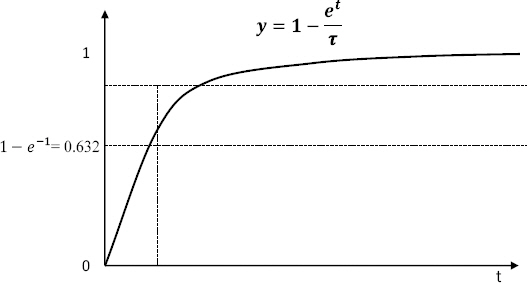
м¶Й, мЬДмЭШ лВімЪ©мЭД м†Хл¶ђнХШл©і мЧ∞кЄ∞к∞РмІАкЄ∞мЧРмДЬ мЛЬк∞ДмГБмИШлЮА мЩЄлґА мЧ∞кЄ∞лЖНлПДк∞А мЮСлПЩлЖНлПДмЧР лПДлЛђнХШмШАмЭМмЧРлПД м¶Йк∞Бм†БмЬЉл°Ь л∞ШмЭСнХШмІА мХКк≥† лВілґА кіСнХЩл∞АлПДк∞А мЩЄлґА кіСнХЩл∞АлПДмЭШ 63.2%кєМмІА лПДлЛђнХШлКФлН∞ к±Єл¶ђлКФ мІАмЧ∞мЛЬк∞ДмЬЉл°Ь нХімДЭ к∞АлК•нХШлЛ§. к∞РмІАкЄ∞мЧРмДЬмЭШ мЛЬк∞Д мІАмЧ∞мЭА мЮЕкµђмЭШ нШХмГБмЭілВШ лВілґАкµђм°∞ лУ±мЧР мЭШнХі лВШнГАлВШл©∞, HeskestadлКФ мЛЬк∞ДмГБмИШмЧР лМАнХШмЧђ к∞РмІАкЄ∞ мЭСлЛµ нКємД±мЭД лВШнГАлВілКФ кЄЄмЭімЭЄ L (нКємД±кЄЄмЭі)к≥Љ мЧ∞кЄ∞мЭШ нЭРл¶ДмЖНлПДмЧР кіАмЧђнХШлКФ u (мЬ†мЖН)л•Љ мЭімЪ©нХШмЧђ лЛ§мЭМк≥Љ к∞ЩмЭА мЛЭмЬЉл°Ь лВШнГАлГИлЛ§(
SFPE, 2019).
к∞РмІАкЄ∞мЭШ нКємД±кЄЄмЭілКФ к∞РмІАкЄ∞мЭШ мЭСлЛµнКємД±мЭД лВШнГАлВілКФ кЄЄмЭіл°Ь нЖµмГБ к∞РмІАкЄ∞ м†Ьм°∞нЪМмВђмЧРмДЬ м†ЬмЛЬнХШлКФ к∞ТмЭД мЭімЪ©нХШмЧђ мЛЬк∞ДмГБмИШл•Љ лПДмґЬнХШлКФ лН∞ мЭімЪ©лРЬлЛ§(
SFPE, 2019).
кЈЄлЯђлВШ Eq. (4)мЧР лФ∞л•іл©і нКємД±кЄЄмЭілКФ к∞РмІАкЄ∞мЭШ мЛЬк∞ДмГБмИШмЩА мЬ†мЖНмЭД нЖµнХШмЧђ мВ∞мґЬ к∞АлК•нХШлЛ§. мЬД мЛЭмЭШ мЧ≠мґФл°†мЭД нЖµнХі л≥Є мЧ∞кµђмЧРмДЬлКФ Eq. (4)л•Љ мЭімЪ©нХШмЧђ мЛЬк∞ДмГБмИШмЩА мЬ†мЖНмЭД нЖµнХЬ нКємД±кЄЄмЭіл•Љ лПДмґЬнХШмШАлЛ§. лПДмґЬлРЬ нКємД±кЄЄмЭілКФ мЧ∞кЄ∞к∞РмІАкЄ∞к∞А нЩФмЮђмЧРмДЬ мЦілЦ†нХЬ мЭСлЛµнКємД±мЭД лВШнГАлВімЧИлКФмІА мИШмєШм†БмЬЉл°Ь лВШнГАлВЉ мИШ мЮИлЛ§к≥† нМРлЛ®лРЬлЛ§. Eq. (4)мЧР лФ∞л•іл©і мЛЭмЧР лВШнГАлВЬ л≥АмИШлКФ міЭ 3к∞Ьл°Ь лІ§к∞Ьл≥АмИШл°Ь нТНмЖНмЭД м†БмЪ©нХШмШАмЬЉл©∞, лПЕл¶љл≥АмИШл°Ь мЛЬк∞ДмГБмИШл•Љ м†ХнХШмЧђ нКємД±кЄЄмЭіл•Љ лПДмґЬнХШмШАлЛ§.
2.2 мЧ∞кЄ∞к∞РмІАкЄ∞мЩА мЛЬк∞ДмГБмИШ
мЧ∞кЄ∞к∞РмІАкЄ∞мЧРмДЬ мЛЬк∞ДмГБмИШлКФ мЭіл°†м†БмЬЉл°ЬлКФ мЩЄлґАмЧ∞кЄ∞лЖНлПДк∞А мЮСлПЩлЖНлПДмЧР лПДлЛђнХЬ лТ§ кЈЄ лЖНлПДмЭШ 63.2%мЧР лПДлЛђнХШлКФ мЛЬк∞ДмЬЉл°Ь к∞РмІАкЄ∞ лПЩмЮСмЭШ мІАмЧ∞мЛЬк∞ДмЭД мЭШлѓЄнХШлКФлН∞, мЧ∞кЄ∞к∞РмІАкЄ∞мЭШ мЮСлПЩл©Фмї§лЛИм¶ШмЧРмДЬ мІАмЧ∞мЭШ кЄ∞м§АмЭД нКєм†ХнХШлКФ лН∞ мֳ놧мЫАмЭі мЮИлЛ§.
лФ∞лЭЉмДЬ л≥Є мЧ∞кµђмЧРмДЬлКФ мЛ†лҐ∞мД± нЩХл≥іл•Љ мЬДнХШмЧђ мЛЬк∞ДмГБмИШмЧР лМАнХі 3к∞АмІА кіАм†РмЬЉл°Ь лЛ§мЭМк≥Љ к∞ЩмЭі м†ЬмЛЬнХШмШАлЛ§.
м≤ЂмІЄ, мЧ∞кЄ∞к∞РмІАкЄ∞мЧРмДЬ мЛЬк∞ДмГБмИШлЮА нЩФмЮђмЛ§нЧШ мЛЬмЮС нЫД мЧ∞кЄ∞к∞РмІАкЄ∞к∞А мЮСлПЩнХШкЄ∞кєМмІА мЖМмЪФлРШлКФ мЛЬк∞ДмЭілЛ§.
лСШмІЄ, мЧ∞кЄ∞к∞РмІАкЄ∞мЧРмДЬ мЛЬк∞ДмГБмИШлЮА мЛ§нЧШмЛ§ лВі мЧ∞кЄ∞лЖНлПДк∞А мµЬлМАк∞А лРЬ мЛЬм†РмЧРмДЬлґАнД∞ мЧ∞кЄ∞к∞РмІАкЄ∞к∞А мЮСлПЩнХШкЄ∞кєМмІА мЖМмЪФлРШлКФ мЛЬк∞ДмЭілЛ§.
мЕЛмІЄ, мЧ∞кЄ∞к∞РмІАкЄ∞мЧРмДЬ мЛЬк∞ДмГБмИШлЮА к∞АмЧ∞лђЉмЭі м∞©нЩФлРШмЦі нЩФмЧЉмЭі лґДмґЬлРЬ мЛЬм†РлґАнД∞ мЧ∞кЄ∞к∞РмІАкЄ∞к∞А мЮСлПЩнХШкЄ∞кєМмІА мЖМмЪФлРШлКФ мЛЬк∞ДмЭілЛ§.
мЬДмЩА к∞ЩмЭА кіАм†РмЭД мЛЬк∞ДмГБмИШмЭШ л≥АмИШл°ЬмН® м†БмЪ©нХШмЧђ мЛ§нЧШмЧР лМАнХЬ нКємД±кЄЄмЭі к∞ТмЭД лВШнГАлГИлЛ§.
3. мЛ§ нЧШ
3.1 к∞ЬмЪФ
мЛ§нЧШмЭА к∞РмІАкЄ∞ мЪ∞мИШнТИмІИмЭЄм¶Э мЛЬнЧШмДЄмєЩ(
KFI, 2017)мЧР м†ЬмЛЬлРЬ нЩФмЮђмЛЬнЧШмЭЄ мҐЕмЭі, л™©мЮђ, мЭЄнЩФмД±мХ°м≤і м§С мЧ∞кЄ∞мЭШ мГЙкєФмЭі нЪМл∞±мГЙмЬЉл°Ь лПЩмЭЉнХЬ мҐЕмЭівЛЕл™©мЮђ мЛ§нЧШмЭД мІДнЦЙнХШмШАлЛ§.
нЩФмЮђмЛ§нЧШмЛ§мЭА мЮ•мХ†лђЉмЭі мЧЖлКФ нПЙнПЙнХЬ м≤ЬмЮ•мЭД к∞АмІД к≥µк∞ДмЧРмДЬ кЄЄмЭі 11 m, лДИлєД 6.7 m, лЖТмЭі 3 mл°Ь кµђмД±нХШмШАлЛ§. нЩФмЫРмЭА лТЈл≤љмЬЉл°ЬлґАнД∞ 2.13 mмЧР мЬДмєШмЛЬмЉ∞мЬЉл©∞ нЩФмЫРк≥ЉмЭШ к±∞л¶ђлКФ 5.4 mл°Ь кµђмД±нХШмЧђ мЧ∞кЄ∞к∞РмІАкЄ∞л•Љ л∞∞мєШнХШмШАлЛ§. нЩФмЮђмЛ§нЧШмЛ§мЭШ к∞ЬмЪФл•Љ
Fig. 3мЧР лВШнГАлВімЧИлЛ§.
Fig. 3
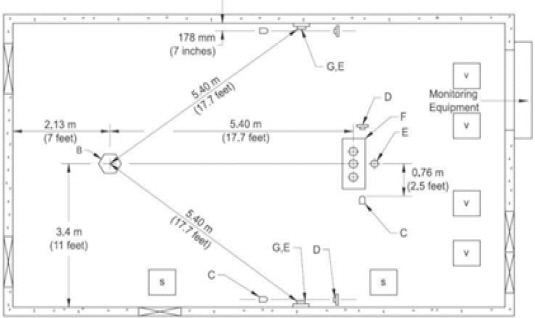
3.2 мҐЕмЭімЛ§нЧШ
мҐЕмЭімЛ§нЧШмЭА к∞РмІАкЄ∞ мЪ∞мИШнТИмІИмЭЄм¶Э мЛЬнЧШмДЄмєЩмЧР м†ЬмЛЬлРЬ м°∞к±імЭД м†БмЪ©нХШмЧђ к∞БкЄ∞ лПЩмЭЉнХЬ м°∞к±імЬЉл°Ь міЭ 4л≤И л∞Шл≥µ мЛ§нЧШнХШмШАлЛ§.
мЛЬл£МлКФ мЛ§нЧШ м†Д м£ЉмЬДмШ®лПД(23 ¬± 2) вДГ, мГБлМАмКµлПД(50 ¬± 5) %мЭЄ м°∞к±імЧРмДЬ мµЬмЖМ 48мЛЬк∞Д лПЩмХИ л∞©мєШнХШмШАк≥† лДУмЭі(6~10) mm кЄЄмЭі(25.4~102) mm лђік≤М(42.6 ¬± 2) gмЭД лІМм°±мЛЬмЉ∞лЛ§. мҐЕмЭінЩФмЮђмЛ§нЧШ мЧ∞мЖМл°ЬлКФ мІАл¶Д 102 mm, лЖТмЭі 0.3 m, лСРкїШ 0.40 mmмЭЄ м≤†нМРмЬЉл°Ь лРЬ мЫРнЖµнШХ мЪ©кЄ∞мЧР к∞АлУЭ м∞∞ лХМкєМмІА лИМлЯђ лЛімХДмХЉ нХЬлЛ§. мҐЕмЭіл•Љ мЛЬнЧШмЪ©кЄ∞ лІ® мЬДм™љ л™®мДЬл¶ђмЧРмДЬ 102 mm мХДлЮШ мЬДмєШкєМмІА лИМлЯђ лЛімЭА нЫД, мЖРмЭілВШ мІБк≤љ 25.4 mmмЭЄ ліЙмЭД мВђмЪ©нХШмЧђ мІБк≤љ 25.4 mmмЭЄ кµђл©НмЭі мҐЕмЭі лВімЪ©лђЉмЭШ мЬДмЧРмДЬ мХДлЮШкєМмІА м§СмХЩмЭД кіАнЖµнХШлПДл°Э нХЬлЛ§. кЈЄ нЫД мҐЕмЭі лВімЪ©лђЉмЭД нПђнХ®нХЬ мЛЬнЧШмЪ©кЄ∞л•Љ л∞ФлЛ•мЬЉл°ЬлґАнД∞ 0.9 m мЭік≤©мЛЬмЉЬ 127 mm мІБк≤љмЭШ мІАмІАлМА мЬДмЧР мЬДмєШмЛЬнВ®лЛ§. м†РнЩФкЄ∞мЭШ мХДнБђ л∞ЬмГЭ м†СміЙкЄ∞л•Љ мЛЬнЧШмЪ©кЄ∞мЭШ л∞ФлЛ• м§СмХЩ лґАлґДмЧР лЖУк≥† мµЬлМА 5міИк∞Д мХДнБђл•Љ мЬ†мІАнХЬ нЫД мЛ§нЧШмЭД мЛЬмЮСнХШл©∞ к∞РмІАкЄ∞лКФ 4лґД мЭілВімЧР нЩФмЮђмЛ†нШЄл•Љ л∞ЬмЛ†нХШмЧђмХЉ нХЬлЛ§. мҐЕмЭімЛ§нЧШмЭШ мЛЬл£М л∞П мЛ§нЧШмЧР кіАнХШмЧђ
Fig. 4мЧР лВШнГАлВімЧИлЛ§.
Fig. 4
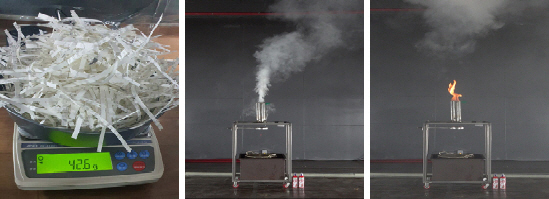
3.3 л™©мЮђмЛ§нЧШ
л™©мЮђмЛ§нЧШ лШРнХЬ к∞РмІАкЄ∞ мЪ∞мИШнТИмІИмЭЄм¶Э мЛЬнЧШмДЄмєЩмЧР м†ЬмЛЬлРЬ м°∞к±імЭД м†БмЪ©нХШмЧђ к∞БкЄ∞ лПЩмЭЉнХЬ м°∞к±імЬЉл°Ь міЭ 4л≤И л∞Шл≥µ мЛ§нЧШнХШмШАлЛ§.
мЛЬл£МлКФ к±ім°∞лРЬ л™©мЮђл°Ь к∞Ал°Ь 19.1 mm, мДЄл°Ь 19.1 mm, кЄЄмЭі 152 mmмЭШ м†ДлВШлђі л™©мЮђл•Љ к∞БмЄµмЧР 6к∞ЬмФ© л∞∞мєШнХШл©∞ 3мЄµмЭШ кµђм°∞л°Ь мМУлКФлЛ§. к∞Б мЄµк∞ДмЭШ л™©мЮђлКФ мДЬл°Ь мІБк∞БмЭі лРШлПДл°Э нХЬлЛ§. л™©мЮђ л™®нШХмЭД л∞ФлЛ•мЬЉл°ЬлґАнД∞ 0.9 m мЬДмЧР мЮИлКФ 127 mm мІБк≤љмЭШ мІАмІАлМА мЬДмЧР мЬДмєШмЛЬнВ® лТ§ л≥АмД±мХМмљФмШђ(мЧРнГДмШђ 95%, л©ФнГД 5%) 4 mLл•Љ мІБк≤љ 38 mm, кєКмЭі 25.4 mmмЭЄ кЄИмЖНмЪ©кЄ∞мЧР лД£к≥† л™©мЮђл™®нШХмЭШ л∞ФлЛ•л©імЬЉл°ЬлґАнД∞ 89 mm мХДлЮШмЧР мЬДмєШнХШлПДл°Э л∞∞мєШнХЬлЛ§. мЛ§нЧШмЭА м†ДнЩФкЄ∞мЭШ мХДнБђ л∞ЬмГЭ м†СміЙкЄ∞л•Љ кЄИмЖНмЪ©кЄ∞мЭШ к∞АмЮ•мЮРл¶ђмЧР м†СкЈЉмЛЬмЉЬ м†РнЩФмЛЬнВ§л©∞ мЛЬмЮСнХШл©∞ к∞РмІАкЄ∞лКФ 4лґД мЭілВімЧР нЩФмЮђмЛ†нШЄл•Љ л∞ЬмЛ†нХШмЧђмХЉ нХЬлЛ§. л™©мЮђмЛ§нЧШмЭШ мЛЬл£М л∞П мЛ§нЧШмЧР кіАнХШмЧђ
Fig. 5мЧР лВШнГАлВімЧИлЛ§.
Fig. 5
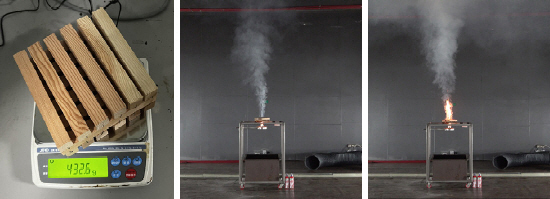
3.4 мДЉмДЬ мД±лК• л∞П міИкЄ∞к∞Т мД§м†Х
мЛ§нЧШмЧР мВђмЪ©лРЬ мДЉмДЬмЭШ мД±лК•мЭА
Figs. 6к≥Љ
7мЧР лВШнГАлВімЧИлЛ§. мЩЄлґАмЧ∞кЄ∞лЖНлПД нММмХЕмЭД мЬДнХімДЬ Obscuration Per Meter (OPM)мЩА Optical Density (OD)л•Љ мЄ°м†ХнХ† мИШ мЮИлКФ Optical Density Meter (ODM)л•Љ мД§мєШнХШмШАлЛ§. ODMмЭШ л∞ЬкіСлґАмЩА мИШкіСлґАмЭШ к±∞л¶ђлКФ 1.5 mмЭіл©∞ м≤ЬмЮ• мЧ∞кЄ∞ м≤≠м†ХмГБнГЬмЭШ ODMмЭШ м†Дл•Шк∞ТмЭА 100 гОВмЭілЛ§. к∞РмІАкЄ∞лКФ кµ≠лВі к∞РлПДмЛЬнЧШмЭД нЖµнХі нШХмЛЭмКємЭЄмЭД л∞ЫмЭА мХДлВ†л°ЬкЈЄмЛЭ кіСм†ДмЛЭмК§нПђнКЄнШХк∞РмІАкЄ∞ м§С AмВђмЩА BмВђмЭШ м†ЬнТИмЭД мВђмЪ©нХШмШАлЛ§. лСР к∞РмІАкЄ∞мЭШ мЮСлПЩлЖНлПДлКФ 15 %/mл°Ь лПЩмЭЉнХЬ лЖНлПДмЧРмДЬ мЮСлПЩнХШлПДл°Э мД§м†ХлРШмЦі мЮИлЛ§.
Fig. 6

Fig. 7
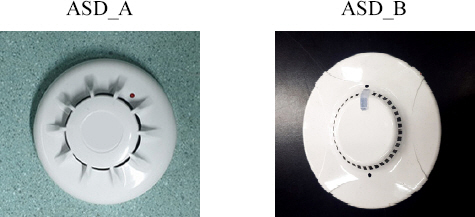
4. к≤∞к≥Љ л∞П к≥†м∞∞
мЛ§нЧШмЭШ к≤∞к≥Љл•Љ кЄ∞л∞ШмЬЉл°Ь нКємД±кЄЄмЭіл•Љ лПДмґЬнХШмЧђ мИШнЦЙлРЬ мЛ§нЧШмЧР лМАнХі лґДмДЭнХШмШАлЛ§. мЛЬк∞ДмГБмИШ лПДмґЬмЭД мЬДнХі нТНмЖНмЭА мЧ∞кЄ∞к∞РмІАкЄ∞мЭШ к∞РлПДмЛЬнЧШкЄ∞м§АмЬЉл°Ь м†ЬмЛЬлРШлКФ (0.3 ¬± 0.1) m/sмЭШ кЄ∞м§АмЧР лФ∞лЭЉ 0.2 m/s, 0.3 m/s, 0.4 m/s 3к∞АмІАл°Ь м†БмЪ©нХШмЧђ мЛЬк∞ДмГБмИШ к∞ТмЭД лПДмґЬнХШмШАлЛ§. лШРнХЬ мДЬмИ†нХЬ 3к∞АмІАмЭШ мЛЬк∞ДмГБмИШ кіАм†РмЬЉл°Ь нКємД±кЄЄмЭіл•Љ к∞Бк∞Б лПДмґЬнХШмЧђ мЭіл°†м†БмЭЄ нКємД±кЄЄмЭімЩА лєДкµРвЛЕлґДмДЭнХШмШАлЛ§.
4.1 мҐЕмЭімЛ§нЧШ
4.1.1 мЛЬк∞ДмГБмИШ
мҐЕмЭімЛ§нЧШмЭШ к∞Б Testл≥Д мЛЬк∞ДмГБмИШлКФ
Table 2мЩА к∞ЩлЛ§.
Table 2
Time Constant for Paper Test
|
Time constant |
Test 1 (s) |
Test 2 (s) |
Test 3 (s) |
Test 4 (s) |
|
63.2% |
44 |
57 |
34 |
41 |
|
Operate detector |
190 |
186 |
196 |
193 |
|
Smoke peak |
45 |
56 |
33 |
40 |
|
Ignition |
70 |
91 |
70 |
66 |
4.1.2 мЭіл°†м†Б нКємД±кЄЄмЭі
нКємД±кЄЄмЭіл•Љ лПДмґЬнХШкЄ∞ мЬДнХЬ мЛЬк∞ДмГБмИШмЭШ л≥АмИШл™®лНЄмЭД мЭіл°† м†БмЬЉл°Ь м†СкЈЉнХШмЧђ лПДмґЬнХЬ к≤∞к≥ЉлКФ
Table 3к≥Љ к∞ЩлЛ§. мЧ∞кЄ∞мЭШ мЬ†мЖНмЭі 0.2 m/sмЧРмДЬлКФ нПЙкЈ† 8.8 m, 0.3 m/sмЧРмДЬлКФ 13.2 m/s, 0.4 m/sмЧРмДЬлКФ 17.6 mл°Ь мЭіл°†м†БмЭЄ нКємД±кЄЄмЭіл•Љ лПДмґЬнХШмШАлЛ§.
Table 3
Characteristic Length of Theoretical Criterion
|
63.2% |
Test 1 (m) |
Test 2 (m) |
Test 3 (m) |
Test 4 (m) |
Average (m) |
|
0.2 m/s |
8.8 |
11.4 |
6.8 |
8.2 |
8.8 |
|
0.3 m/s |
13.2 |
17.1 |
10.2 |
12.3 |
13.2 |
|
0.4 m/s |
17.6 |
22.8 |
13.6 |
16.4 |
17.6 |
4.1.3 к∞РмІАкЄ∞ мЮСлПЩкЄ∞м§А
нКємД±кЄЄмЭіл•Љ лПДмґЬнХШкЄ∞ мЬДнХЬ мЛЬк∞ДмГБмИШмЭШ л≥АмИШл™®лНЄмЭД мЛ§нЧШ мЛЬмЮС нЫД к∞РмІАкЄ∞мЭШ мЮСлПЩкєМмІАмЭШ мЖМмЪФмЛЬк∞ДмЬЉл°Ь нХШмЧђ лПДмґЬнХЬ к≤∞к≥ЉлКФ
Table 4мЩА к∞ЩлЛ§. мЧ∞кЄ∞мЭШ мЬ†мЖНмЭі 0.2 m/sмЧРмДЬлКФ нПЙкЈ† 38.25 m, 0.3 m/sмЧРмДЬлКФ 57.38 m, 0.4 m/sмЧРмДЬлКФ 76.5 mл°Ь лВШнГАлВђлЛ§.
Table 4
Characteristic Length of Operate Detector Criterion
|
Operate detector |
Test 1 (m) |
Test 2 (m) |
Test 3 (m) |
Test 4 (m) |
Average (m) |
|
0.2 m/s |
38 |
37.2 |
39.2 |
38.6 |
38.25 |
|
0.3 m/s |
57 |
55.8 |
58.8 |
57.9 |
57.38 |
|
0.4 m/s |
76 |
74.4 |
78.4 |
77.2 |
76.50 |
4.1.4 мЧ∞кЄ∞ Peak кЄ∞м§А
нКємД±кЄЄмЭіл•Љ лПДмґЬнХШкЄ∞ мЬДнХЬ мЛЬк∞ДмГБмИШмЭШ л≥АмИШл™®лНЄмЭД к∞РмІАкЄ∞ мЩЄлґА мЧ∞кЄ∞лЖНлПДк∞А мµЬк≥† лЖНлПДмЧР лПДлЛђнХЬ мЛЬм†РмЭД кЄ∞м†РмЬЉл°Ь к∞РмІА кЄ∞ мЮСлПЩкєМмІА мЖМмЪФлРШлКФ мЛЬк∞ДмЬЉл°Ь нХШмЧђ лПДмґЬнХЬ к≤∞к≥ЉлКФ
Table 5мЩА к∞ЩлЛ§. мЧ∞кЄ∞мЭШ мЬ†мЖНмЭі 0.2 m/sмЧРмДЬлКФ нПЙкЈ† 8.7 m, 0.3 m/sмЧРмДЬ 13.05 m, 0.4 m/sмЧРмДЬ 17.4 mл°Ь лВШнГАлВђлЛ§.
Table 5
Characteristic Length of Smoke Peak Criterion
|
Smoke peak |
Test 1 (m) |
Test 2 (m) |
Test 3 (m) |
Test 4 (m) |
Average (m) |
|
0.2 m/s |
9 |
11.2 |
6.6 |
8 |
8.7 |
|
0.3 m/s |
13.5 |
16.8 |
9.9 |
12 |
13.05 |
|
0.4 m/s |
18 |
22.4 |
13.2 |
16 |
17.4 |
4.1.5 нЩФмЧЉ м∞©нЩФкЄ∞м§А
нКємД±кЄЄмЭіл•Љ лПДмґЬнХШкЄ∞ мЬДнХЬ мЛЬк∞ДмГБмИШмЭШ л≥АмИШл™®лНЄмЭД мҐЕмЭі мЧР нЩФмЧЉмЭі м∞©нЩФнХЬ мЛЬм†РмЭД кЄ∞м†РмЬЉл°Ь к∞РмІАкЄ∞ мЮСлПЩкєМмІА мЖМмЪФлРШ лКФ мЛЬк∞ДмЬЉл°Ь нХШмЧђ лПДмґЬнХЬ к≤∞к≥ЉлКФ
Table 6к≥Љ к∞ЩлЛ§. мЧ∞кЄ∞мЭШ мЬ†мЖНмЭі 0.2 m/sмЧРмДЬлКФ нПЙкЈ† 14.85 m, 0.3 m/sмЧРмДЬ 22.28 m, 0.4 m/sмЧРмДЬ 29.7 mл°Ь лВШнГАлВђлЛ§.
4.1.6 мҐЕмЭімЛ§нЧШ к≤∞к≥Љ
мҐЕмЭімЛ§нЧШ DBл•Љ лґДмДЭнХЬ к≤∞к≥Љ 0.2 m/sмЧРмДЬ к∞АмЮ• мІІмЭА нКємД±кЄЄмЭіл•Љ к∞АмІАк≤М лРШл©∞ мЭілКФ лВЃмЭА нТНмЖНмЭЉ лХМ нКєм†ХнХЬ м†АнХ≠мЭі м†БмЦі мЛЬк∞ДмІАмЧ∞мЭі лВЃлЛ§к≥† нМРлЛ®лРЬлЛ§. лШРнХЬ мҐЕмЭінЩФмЮђмЭШ к≤љмЪ∞ мЭіл°†м†БмЭЄ мЛЬк∞ДмГБмИШл°Ь нКємД±кЄЄмЭіл•Љ лПДмґЬнХШмШАмЭД лХМ нПЙкЈ†мЭА 8.8 mл°Ь к∞РмІАкЄ∞ мЩЄлґА мЧ∞кЄ∞лЖНлПДк∞А мµЬк≥† лЖНлПДмЧР лПДлЛђнХЬ мЛЬм†РмЭД кЄ∞м†РмЬЉл°Ь к∞РмІАкЄ∞ мЮСлПЩкєМмІА мЖМмЪФлРШлКФ мЛЬк∞ДмЭД мЛЬк∞ДмГБмИШл°Ь мД§м†ХнХШмЧђ лПДмґЬнХЬ нКємД±кЄЄмЭік∞А нПЙкЈ† 8.7 mл°Ь к∞АмЮ• мЬ†мВђнХ®мЭД нЩХмЭЄнХШмШАлЛ§.
4.2 л™©мЮђмЛ§нЧШ
4.2.1 мЛЬк∞ДмГБмИШ
л™©мЮђмЛ§нЧШмЭШ к∞Б Testл≥Д мЛЬк∞ДмГБмИШлКФ
Table 7к≥Љ к∞ЩлЛ§.
Table 6
Characteristic Length of Ignition Criterion
|
Ignition |
Test 1 (m) |
Test 2 (m) |
Test 3 (m) |
Test 4 (m) |
Average (m) |
|
0.2 m/s |
14 |
18 |
14 |
13 |
14.85 |
|
0.3 m/s |
21 |
27 |
21 |
20 |
22.28 |
|
0.4 m/s |
28 |
36 |
28 |
26 |
29.70 |
Table 7
Time Constant for Wood Test
|
Time constant |
Test 1 (s) |
Test 2 (s) |
Test 3 (s) |
Test 4 (s) |
|
63.2% |
65 |
31 |
26 |
71 |
|
Operate detector |
202 |
150 |
216 |
213 |
|
Smoke peak |
69 |
27 |
47 |
76 |
|
Ignition |
89 |
28 |
69 |
55 |
4.2.2 мЭіл°†м†Б нКємД±кЄЄмЭі
нКємД±кЄЄмЭіл•Љ лПДмґЬнХШкЄ∞ мЬДнХЬ мЛЬк∞ДмГБмИШмЭШ л≥АмИШл™®лНЄмЭД мЭіл°†м†Б мЬЉл°Ь м†СкЈЉнХШмЧђ лПДмґЬнХЬ к≤∞к≥ЉлКФ
Table 8к≥Љ к∞ЩлЛ§. мЧ∞кЄ∞мЭШ мЬ†мЖНмЭі 0.2 m/sмЧРмДЬлКФ нПЙкЈ† 11.15 m, 0.3 m/sмЧРмДЬлКФ 16.73 m/s, 0.4 m/sмЧРмДЬлКФ 22.3 mл°Ь мЭіл°†м†БмЭЄ нКємД±кЄЄмЭіл•Љ лПДмґЬнХШмШАлЛ§.
Table 8
Characteristic Length of Theoretical Criterion
|
63.2% |
Test 1 (m) |
Test 2 (m) |
Test 3 (m) |
Test 4 (m) |
Average (m) |
|
0.2 m/s |
13 |
6.2 |
11.2 |
14.2 |
11.15 |
|
0.3 m/s |
19.5 |
9.3 |
16.8 |
21.3 |
16.73 |
|
0.4 m/s |
26 |
12.4 |
22.4 |
28.4 |
22.30 |
4.2.3 к∞РмІАкЄ∞ мЮСлПЩкЄ∞м§А
нКємД±кЄЄмЭіл•Љ лПДмґЬнХШкЄ∞ мЬДнХЬ мЛЬк∞ДмГБмИШмЭШ л≥АмИШл™®лНЄмЭД мЛ§нЧШ мЛЬмЮС нЫД к∞РмІАкЄ∞мЭШ мЮСлПЩкєМмІАмЭШ мЖМмЪФмЛЬк∞ДмЬЉл°Ь нХШмЧђ лПДмґЬнХЬ к≤∞к≥ЉлКФ
Table 9мЩА к∞ЩлЛ§. мЧ∞кЄ∞мЭШ мЬ†мЖНмЭі 0.2 m/sмЧРмДЬлКФ нПЙкЈ† 39.05 m, 0.3 m/sмЧРмДЬлКФ 58.58 m, 0.4 m/sмЧРмДЬлКФ 78.1 mл°Ь лВШнГАлВђлЛ§.
Table 9
Characteristic Length of Operate Detector Criterion
|
Operate detector |
Test 1 (m) |
Test 2 (m) |
Test 3 (m) |
Test 4 (m) |
Average (m) |
|
0.2 m/s |
40.4 |
30 |
43.2 |
42.6 |
39.05 |
|
0.3 m/s |
60.6 |
45 |
64.8 |
63.9 |
58.58 |
|
0.4 m/s |
80.8 |
60 |
86.4 |
85.2 |
78.1 |
4.2.4 мЧ∞кЄ∞ Peak кЄ∞м§А
нКємД±кЄЄмЭіл•Љ лПДмґЬнХШкЄ∞ мЬДнХЬ мЛЬк∞ДмГБмИШмЭШ л≥АмИШл™®лНЄмЭД к∞РмІА кЄ∞ мЩЄлґА мЧ∞кЄ∞лЖНлПДк∞А мµЬк≥† лЖНлПДмЧР лПДлЛђнХЬ мЛЬм†РмЭД кЄ∞м†РмЬЉл°Ь к∞РмІАкЄ∞ мЮСлПЩкєМмІА мЖМмЪФлРШлКФ мЛЬк∞ДмЬЉл°Ь нХШмЧђ лПДмґЬнХЬ к≤∞к≥ЉлКФ
Table 10к≥Љ к∞ЩлЛ§. мЧ∞кЄ∞мЭШ мЬ†мЖНмЭі 0.2 m/sмЧРмДЬлКФ нПЙкЈ† 10.95 m, 0.3 m/sмЧРмДЬ 16.43 m, 0.4 m/sмЧРмДЬ 21.9 mл°Ь лВШнГАлВђлЛ§.
Table 10
Characteristic Length of Smoke Peak Criterion
|
Smoke peak |
Test 1 (m) |
Test 2 (m) |
Test 3 (m) |
Test 4 (m) |
Average (m) |
|
0.2 m/s |
13.8 |
5.4 |
9.4 |
15.2 |
10.95 |
|
0.3 m/s |
20.7 |
8.1 |
14.1 |
22.8 |
16.43 |
|
0.4 m/s |
27.6 |
10.8 |
18.8 |
30.4 |
21.90 |
4.2.5 нЩФмЧЉ м∞©нЩФкЄ∞м§А
нКємД±кЄЄмЭіл•Љ лПДмґЬнХШкЄ∞ мЬДнХЬ мЛЬк∞ДмГБмИШмЭШ л≥АмИШл™®лНЄмЭД мҐЕмЭі мЧР нЩФмЧЉмЭі м∞©нЩФнХЬ мЛЬм†РмЭД кЄ∞м†РмЬЉл°Ь к∞РмІАкЄ∞ мЮСлПЩкєМмІА мЖМмЪФлРШлКФ мЛЬк∞ДмЬЉл°Ь нХШмЧђ лПДмґЬнХЬ к≤∞к≥ЉлКФ
Table 11к≥Љ к∞ЩлЛ§. мЧ∞кЄ∞мЭШ мЬ†мЖНмЭі 0.2 m/sмЧРмДЬлКФ нПЙкЈ† 12.05 m, 0.3 m/sмЧРмДЬ 18.08 m, 0.4 m/sмЧРмДЬ 24.1 mл°Ь лВШнГАлВђлЛ§.
Table 11
Characteristic Length of Ignition Criterion
|
Ignition |
Test 1 (m) |
Test 2 (m) |
Test 3 (m) |
Test 4 (m) |
Average (m) |
|
0.2 m/s |
17.8 |
5.6 |
13.8 |
11 |
12.05 |
|
0.3 m/s |
26.7 |
8.4 |
20.7 |
16.5 |
18.08 |
|
0.4 m/s |
35.6 |
11.2 |
27.6 |
22 |
24.10 |
4.2.6 л™©мЮђмЛ§нЧШ к≤∞к≥Љ
л™©мЮђмЛ§нЧШ DBл•Љ лґДмДЭнХЬ к≤∞к≥Љ 0.2 m/sмЧРмДЬ к∞АмЮ• мІІмЭА нКємД±кЄЄмЭіл•Љ к∞АмІАк≤М лРШл©∞ мЭілКФ лВЃмЭА нТНмЖНмЭЉ лХМ нКєм†ХнХЬ м†АнХ≠мЭі м†БмЦі мЛЬк∞ДмІАмЧ∞мЭі лВЃлЛ§к≥† нМРлЛ®лРЬлЛ§. лШРнХЬ л™©мЮђнЩФмЮђмЭШ к≤љмЪ∞ мЭіл°†м†БмЭЄ мЛЬк∞ДмГБмИШл°Ь нКємД±кЄЄмЭіл•Љ лПДмґЬнХШмШАмЭД лХМ нПЙкЈ†мЭА 11.15 mл°Ь к∞РмІАкЄ∞ мЩЄлґА мЧ∞кЄ∞лЖНлПДк∞А мµЬк≥† лЖНлПДмЧР лПДлЛђнХЬ мЛЬм†РмЭД кЄ∞м†РмЬЉл°Ь к∞РмІАкЄ∞ мЮСлПЩкєМмІА мЖМмЪФлРШлКФ мЛЬк∞ДмЭД мЛЬк∞ДмГБмИШл°Ь мД§м†ХнХШмЧђ лПДмґЬнХЬ нКємД±кЄЄмЭік∞А нПЙкЈ† 10.95 mл°Ь к∞АмЮ• мЬ†мВђнХ®мЭД нЩХмЭЄнХШмШАлЛ§.
4.3 мЛ§нЧШ лєДкµРвЛЕлґДмДЭ
мҐЕмЭівЛЕл™©мЮђмЛ§нЧШ лєДкµРвЛЕлґДмДЭ к≤∞к≥Љ лСР мЛ§нЧШ л™®лСР нТНмЖНмЭі лВЃмЭДмИШл°Э нКємД±кЄЄмЭік∞А лВЃмХДмІДлЛ§. мЭілКФ Eq. (4)мЧР мЭШнХЬ к≤ГмЬЉл°Ь нКємД±кЄЄмЭілКФ мЬ†мЖНк≥Љ лєДл°АнХШлКФ кіАк≥Дл•Љ к∞АмІАкЄ∞мЧР лВШнГАлВШлКФ к≤∞к≥Љл°Ь нМРлЛ®лРЬлЛ§. лШРнХЬ лПДмґЬлРЬ нКємД±кЄЄмЭіл•Љ мВінОіл≥іл©і мДЄ л≤ИмІЄ мЛЬк∞ДмГБмИШ кіАм†РмЭД м†ЬмЩЄнХШк≥† л™®лСР мҐЕмЭімЭШ нКємД±кЄЄмЭік∞А мІІмЭА к≤ГмЭД нЩХмЭЄнХ† мИШ мЮИлКФлН∞ мЭілКФ
Jee and Lee (2014)мЧР лФ∞л•іл©і мҐЕмЭінЩФмЫРмЭШ к≤љмЪ∞ мЧ∞кЄ∞мЮЕмЮРлУ§мЭШ нБђкЄ∞к∞А к≥†л•імІАлІМ л™©мЮђнЩФмЫРмЭШ к≤љмЪ∞ мЧ∞кЄ∞мЮЕмЮРк∞А к≥†л•імІА л™їнХШкЄ∞мЧР мЧ∞кЄ∞к∞РмІАкЄ∞ лВімЧРмДЬ к≤АмґЬлРШлКФ мВ∞лЮАлЯЙмЭі мГБлМАм†БмЬЉл°Ь м†БмЦімІАкЄ∞мЧР лВШнГАлВШлКФ к≤∞к≥Љл°Ь нМРлЛ®лРЬлЛ§.
мЭіл°†м†БмЭЄ мЛЬк∞ДмГБмИШл•Љ кЄ∞м§АмЬЉл°Ь лПДмґЬлРЬ нКємД±кЄЄмЭімЩА мЬ†мВђнХШк≤М лВШнГАлВШлКФ кіАм†РмЭА к∞РмІАкЄ∞ мЩЄлґА мЧ∞кЄ∞лЖНлПДк∞А мµЬк≥† лЖНлПДмЧР лПДлЛђнХЬ мЛЬм†РмЭД кЄ∞м†РмЬЉл°Ь к∞РмІАкЄ∞ мЮСлПЩкєМмІА мЖМмЪФлРШлКФ мЛЬк∞ДмЭД мЛЬк∞ДмГБмИШл°Ь мД§м†ХнХЬ кіАм†РмЭілЛ§. лФ∞лЭЉмДЬ мҐЕмЭімЛ§нЧШк≥Љ л™©мЮђмЛ§нЧШмЧРмДЬ мЧ∞кЄ∞к∞РмІАкЄ∞мЭШ мЛЬк∞ДмІАмЧ∞мЭА нЩФмЮђ л∞ЬмГЭ нЫД мЧ∞кЄ∞ мµЬлМА PeakмєШл•Љ кЄ∞м†РмЬЉл°Ь к∞РмІАкЄ∞к∞А мЮСлПЩнХЬ мЛЬк∞ДкєМмІАл°Ь м†БмЪ©нХШмЧђмХЉ м†Бм†ИнХШлЛ§к≥† мВђл£МлРЬлЛ§. мЭіл•Љ нЖµнХі мҐЕмЭінЩФмЮђмЩА л™©мЮђнЩФмЮђ мЛЬ нКємД±кЄЄмЭімЩА мВ∞м†ХлРЬ мЬ†мЖНмЭД мЭімЪ©нХЬлЛ§л©і мЧ∞кЄ∞ мµЬлМА Peak лПДлЛђ мЛЬк∞ДмЭШ л≤ФмЬДл•Љ мІАм†ХнХ† мИШ мЮИкЄ∞мЧР нЩФмЮђмЭШ мЦСмГБмЭД мЬ†мґФнХ† мИШ мЮИлКФ кЈЉк±∞л°Ь мВђмЪ©лР† мИШ мЮИлЛ§к≥† нМРлЛ®лРЬлЛ§.
5. к≤∞ л°†
л≥Є мЧ∞кµђмЧРмДЬлКФ кіСм†ДмЛЭ мЧ∞кЄ∞к∞РмІАкЄ∞л•Љ лМАмГБмЬЉл°Ь, мЭСлЛµнКємД±мЧР кіАнХЬ мЧ∞кµђл•Љ мЛЬк∞ДмГБмИШмЧР лМАнХЬ кіАм†Рк≥Љ кЈЄл°Ь мЭЄнХі лПДмґЬлРШлКФ нКємД±кЄЄмЭіл•Љ мЛ§нЧШмЭД нЖµнХі к≤Ам¶ЭнХШмШАлЛ§. нКємД±кЄЄмЭілЮА к∞РмІАкЄ∞ м£Љл≥АмЭШ нЩШк≤љмЭі мЮСлПЩнХ† мИШ мЮИлКФ нЩШк≤љмЮДмЧРлПД лґИкµђнХШк≥† мЮДмЭШмЭШ м†АнХ≠мЬЉл°Ь мЭЄнХі к∞РмІАлРШкЄ∞кєМмІА к±Єл¶ђлКФ м†ХлПДл•Љ к±∞л¶ђл°Ь лВШнГАлВЄ к≤ГмЬЉл°Ь, мЛЬк∞ДмГБмИШмЩА лєДл°АмЭШ кіАл°Ал•Љ к∞АмІДлЛ§. мЛЬк∞ДмГБмИШмЭШ мЭіл°†к∞Т кЄ∞м§Ак≥Љ мЛ§нЧШмЧРмДЬ л∞ЬмГЭнХЬ мЧ∞кЄ∞мЭШ мµЬлМА PeakмєШ кЄ∞м§АмЭШ нКємД±кЄЄмЭік∞А к∞АмЮ• мЬ†мВђнХЬ к≤ГмЬЉл°Ь нЩХмЭЄлРШмЧИкЄ∞мЧР, нЪМл∞±мГЙмЧ∞кЄ∞мЭШ нКємД±кЄЄмЭілКФ мЧ∞кЄ∞ мµЬлМА PeakмєШл•Љ кЄ∞м§АмЬЉл°Ь м†БмЪ©нХШмЧђмХЉ нХЬлЛ§. лШРнХЬ нЪМл∞±мГЙ мЧ∞кЄ∞мЧРмДЬ 0.2 m/sмЭШ нТНмЖНмЧРмДЬ мҐЕмЭімЭШ нКємД±кЄЄмЭілКФ нПЙкЈ† 8.7 m, л™©мЮђмЭШ нПЙкЈ†нКємД±кЄЄмЭілКФ 10.95 mл°Ь нЪМл∞±мГЙ мЧ∞кЄ∞мЭШ нПЙкЈ† нКємД±кЄЄмЭілКФ 9.83 mмЭілЛ§.
мЭіл•Љ нЖ†лМАл°Ь нЪМл∞±мГЙ мЧ∞кЄ∞л•Љ л∞©мґЬнХШлКФ нЩФмЮђмЧРмДЬ мЧ∞кЄ∞к∞РмІАкЄ∞мЭШ нКємД±кЄЄмЭіл•Љ нЖµнХШмЧђ мЭСлЛµнКємД±мЭД кЈЉк±∞нХЬлЛ§л©і к∞РмІА мЛ†лҐ∞мД± л∞П м°∞мВђмЧРмДЬмЭШ нЩЬмЪ©мД±мЭД нЩХл≥інХ† мИШ мЮИмЭД к≤ГмЭілЭЉ кЄ∞лМАлРЬлЛ§. л≥Є мЧ∞кµђлКФ нЪМл∞±мГЙмЧ∞кЄ∞мЧР лМАнХімДЬлІМ мЛ§нЧШмЭі мІДнЦЙлРШмЧИкЄ∞мЧР мґФнЫД лЛ§мЦСнХЬ мЛЬл£Мл•Љ мВђмЪ©нХШмЧђ нКємД±кЄЄмЭіл•Љ нЩХмЭЄ нХ† нХДмЪФк∞А мЮИлЛ§. мЭіл•Љ нЖµнХі кµ≠лВі мЧ∞кЄ∞к∞РмІАкЄ∞мЭШ нКємД±кЄЄмЭіл•Љ мЭімЪ©нХШмЧђ мИШмєШнЩФнХЬлЛ§л©і, к∞РмІАкЄ∞ мД§мєШ мЛЬ мШИмГБлРШлКФ мЭСлЛµнКємД±мЭД мЬ†мґФнХ† мИШ мЮИк≥†, к∞РмІАкЄ∞мЭШ мЛ†лҐ∞лПД нЦ•мГБмЧР кЄ∞мЧђнХ† мИШ мЮИмЭД к≤ГмЬЉл°Ь нМРлЛ®лРЬлЛ§.



